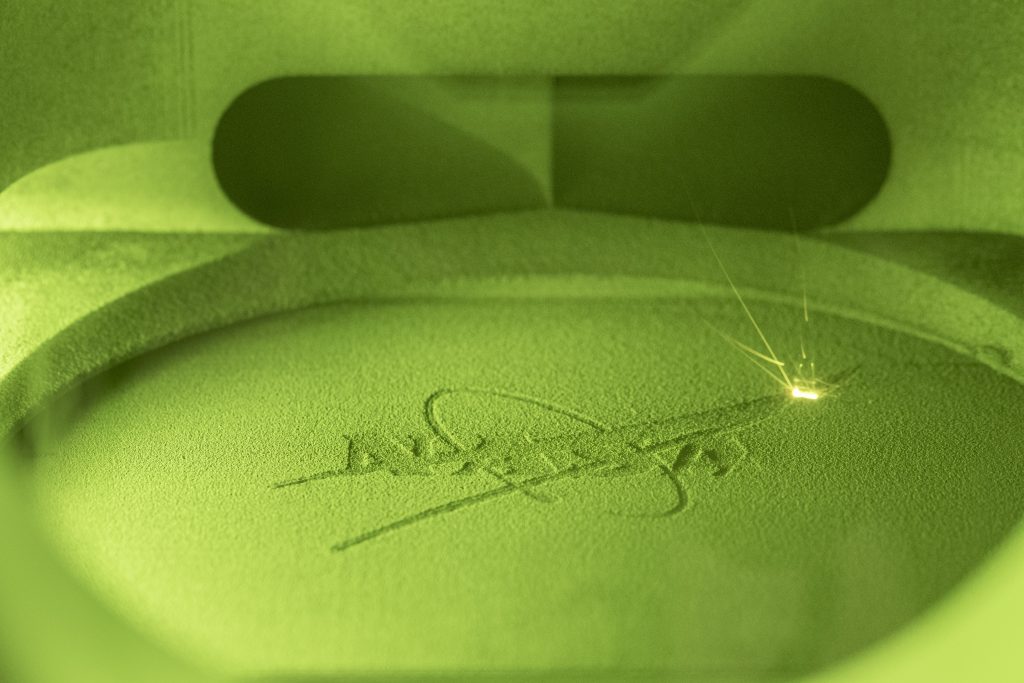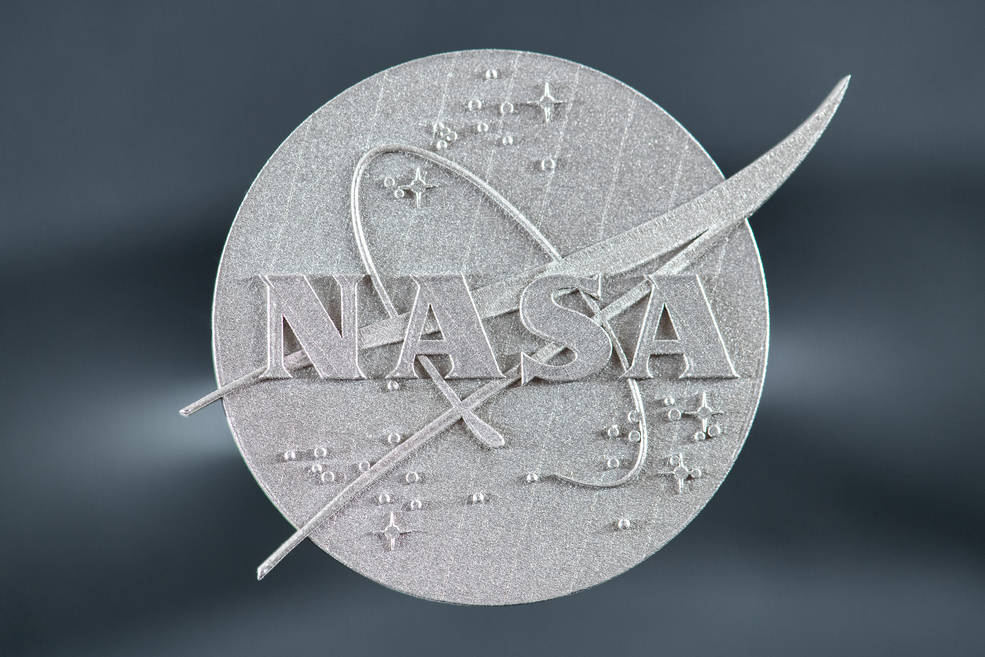NASA, the US National Aeronautics and Space Administration, has announced that it has licensed its GRX-810 superalloy to five US-based companies.
Unveiled last year, GRX-810 is an Oxide Dispersion Strengthened (ODS) alloy designed to withstand the extreme temperatures and demanding conditions of air and spaceflight.
According to NASA, the material is twice as strong and a thousand times more durable than other 3D printable superalloys. Capable of withstanding temperatures over 2,000 degrees Fahrenheit, GRX-810 also boasts a lifespan of two and a half thousand times longer than traditional alloys. As such, aviation and aerospace parts 3D printed in this high-temperature material can withstand more punishment before reaching their breaking point.
Now, NASA has agreed to license its high-performance material to metal 3D printing material developers Carpenter Technology Corporation, Elementum 3D, Linde Advanced Material Technologies, Inc., and Powder Alloy Corporation. The co-exclusive agreement will allow these US firms to manufacture and sell GRX-810 to aviation and aerospace equipment manufacturers, as well as the broader supply chain.
These agreements have been delivered via NASA’s Technology Transfer Program, which files patent applications for new technologies and identifies commercialization partners.

NASA’s new high-performance, 3D printable superalloy
NASA first announced the development of GRX-810 in April last year, hailing it as a “breakthrough in 3D printable high-temperature materials.”
The material was invented by Dr Tim Smith and Christopher Kantzos at NASA’s Glenn Research Center in Cleveland. According to Smith, the new superalloy can dramatically improve the strength and toughness of parts used in aviation and space exploration.
Compared to nickel-based alloys, NASA’s new material can endure higher temperatures and stress. The new material is nearly four times better at flexing before breaking while being twice as resistant to oxidation.
As an ODS, GRX-810 features tiny particles containing oxygen atoms dispersed throughout the alloy. This facilitates its significantly enhanced strength, making it ideal for the production of aerospace and aviation parts that are often subjected to high temperatures and harsh conditions.
When unveiling the material for the first time, Dale Hopkins, deputy project manager of NASA’s Transformational Tools and Technologies project, called the superalloy “a major achievement.” He added, “In the very near future, it may well be one of the most successful technology patents NASA Glenn has ever produced.”

GRX-810 to enter the commercial aviation and aerospace markets
According to NASA, licensing its invention to American companies will directly benefit the US economy as a return on investment of taxpayer dollars.
“NASA invests tax dollars into research that demonstrates direct benefit to the U.S. and transfers its technologies to industry by licensing its patents,” explained Amy Hiltabidel, licensing manager at the Glenn Research Center.
The licensing of GRX-810 continues NASA’s long term efforts to support aerospace and aviation firms in solving complex space exploration challenges and improving air transportation. In fact, the organization has so far spun off over 2,000 technologies for US companies to develop into new products.
NASA also believes that increased adoption of its newest superalloy will enable more sustainable aviation and spaceflight. 3D printed jet engine and rocket components made from GRX-810 will last longer before needing to be replaced, lowering operating costs and material usage in the process.
Additionally, It is hoped that the increased commercialization of the material will result in the development of more energy-efficient engines for rockets and airplanes. Powder Alloy Corporation has already outlined its plans to distribute the alloy for the production of satellite components, spacecraft structures, and aerospace propulsion systems.
This follows the news last year that US-based 3D printer manufacturer 3D Systems completed the successful verification of properties for GRX-810. The company successfully processed and tested the high-temperature mechanical properties of the superalloy using its Direct metal printing (DMP) additive manufacturing platform. Here, 3D Systems’ demonstrated the material’s performance across a range of equipment and processing parameters.

3D printing superalloys
GRX-810 is the latest high-performance superalloy that NASA has developed. In 2019, the organization announced the development of GRCop-42, a high-strength, high-conductivity copper-based alloy optimized for rocket propulsion components. According to NASA, parts 3D printed from this material demonstrate high thermal conductivity, excellent creep (deformation) resistance, and impressive strength at elevated temperatures.
As with GRX-810, GRCop-42 has been expanded into the commercial space. In 2021, rocket engine manufacturer PANGEA Aerospace and additive manufacturing engineering firm AENIUM partnered to develop 3D printed rocket propulsion systems.
Produced using GRCop-42, the rocket engines were produced and commercialized for the European aerospace market. According to the companies, 3D printing the parts from NASA’s high-temperature material enabled the production of a functional engine quicker and for less cost than had previously been possible.
It was announced last year that metal 3D printer manufacturer Nikon SLM Solutions had created new material parameters for the GRCop-42 copper alloy. Called a “ready-made solution,” these new parameters have been developed to meet the growing demand for GRCop-42 in the space industry.
The company hopes that these parameters will overcome powder challenges and enable service providers to 3D print key space components on Nikon SLM 3D printers.
Away from GRCop-42, UC Santa Barbara and Oak Ridge National Laboratory developed a defect-resistant Co-Ni superalloy for metal 3D printing. This material reportedly overcomes the issue of cracking, which is a key barrier in high-temperature powder bed fusion technologies such as SLM and EBM.
The team believes that this material offers notable potential for 3D printing in high-stress applications, including the production of aerospace engines and chemical-contacting nuclear components. Significantly, the superalloy maintains its integrity at 90% of its melting temperature. It also boasts tensile strengths of around 1.1 GPa and an elongation at break greater than 13%.
Want to help select the winners of the 2024 3D Printing Industry Awards? Join the Expert Committee today.
What does the future of 3D printing hold?
What near-term 3D printing trends have been highlighted by industry experts?
Subscribe to the 3D Printing Industry newsletter to keep up to date with the latest 3D printing news.
You can also follow us on Twitter, like our Facebook page, and subscribe to the 3D Printing Industry Youtube channel to access more exclusive content.
Featured image shows the NASA insignia being 3D printed using the GRX-810 superalloy. Photo via NASA/Jordan Salkin

